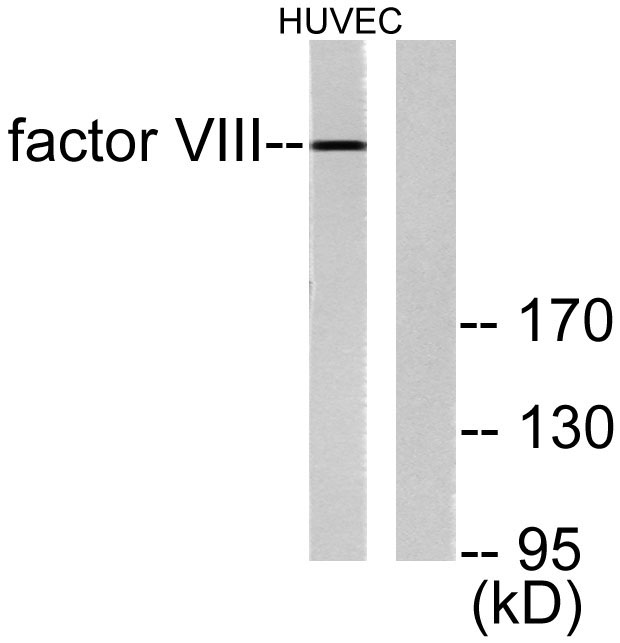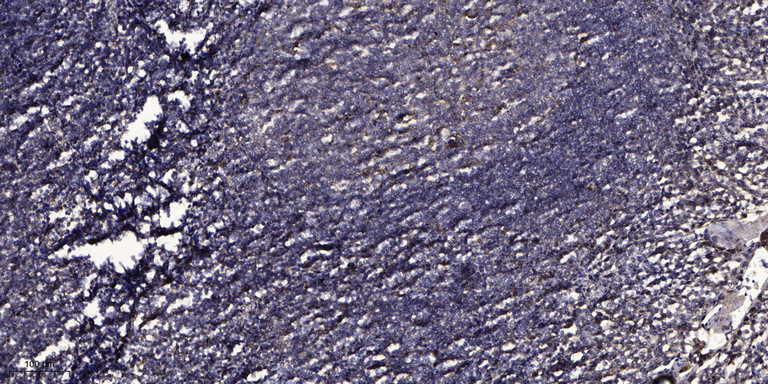Factor VIII Polyclonal Antibody
- Catalog No.:YT1653
- Applications:WB;IHC;IF;ELISA
- Reactivity:Human;Mouse
- Target:
- Factor VIII
- Fields:
- >>Complement and coagulation cascades
- Gene Name:
- F8
- Protein Name:
- Coagulation factor VIII
- Human Gene Id:
- 2157
- Human Swiss Prot No:
- P00451
- Mouse Gene Id:
- 14069
- Mouse Swiss Prot No:
- Q06194
- Immunogen:
- The antiserum was produced against synthesized peptide derived from human Factor VIII. AA range:2161-2210
- Specificity:
- Factor VIII Polyclonal Antibody detects endogenous levels of Factor VIII protein.
- Formulation:
- Liquid in PBS containing 50% glycerol, 0.5% BSA and 0.02% sodium azide.
- Source:
- Polyclonal, Rabbit,IgG
- Dilution:
- WB 1:500 - 1:2000. IHC 1:100 - 1:300. ELISA: 1:10000.. IF 1:50-200
- Purification:
- The antibody was affinity-purified from rabbit antiserum by affinity-chromatography using epitope-specific immunogen.
- Concentration:
- 1 mg/ml
- Storage Stability:
- -15°C to -25°C/1 year(Do not lower than -25°C)
- Other Name:
- F8;F8C;Coagulation factor VIII;Antihemophilic factor;AHF;Procoagulant component
- Observed Band(KD):
- 300kD
- Background:
- This gene encodes coagulation factor VIII, which participates in the intrinsic pathway of blood coagulation; factor VIII is a cofactor for factor IXa which, in the presence of Ca+2 and phospholipids, converts factor X to the activated form Xa. This gene produces two alternatively spliced transcripts. Transcript variant 1 encodes a large glycoprotein, isoform a, which circulates in plasma and associates with von Willebrand factor in a noncovalent complex. This protein undergoes multiple cleavage events. Transcript variant 2 encodes a putative small protein, isoform b, which consists primarily of the phospholipid binding domain of factor VIIIc. This binding domain is essential for coagulant activity. Defects in this gene results in hemophilia A, a common recessive X-linked coagulation disorder. [provided by RefSeq, Jul 2008],
- Function:
- disease:Defects in F8 are the cause of hemophilia A (HEMA) [MIM:306700]. HEMA is a common recessive X-linked coagulation disorder. The frequency of hemophilia A is 1-2 in 10,000 male births in all ethnic groups. About 50% of patients have severe hemophilia A with F8C activity less than 1% of normal; they have frequent spontaneous bleeding into joints, muscles and internal organs. Moderately severe hemophilia A occurs in about 10% of patients; F8C activity is 2-5% of normal, and there is bleeding after minor trauma. Mild hemophilia A, which occurs in 30-40% of patients, is associated with F8C activity of 5-30% and bleeding occurs only after significant trauma or surgery. Of particular interest for the understanding of the function of F8C is the category of CRM (cross-reacting material) positive patients (approximately 5%) that have considerable amount of F8C in their plasma (at least 30%
- Subcellular Location:
- Secreted, extracellular space.
- Expression:
- Brain,Hippocampus,Kidney,Plasma,
- June 19-2018
- WESTERN IMMUNOBLOTTING PROTOCOL
- June 19-2018
- IMMUNOHISTOCHEMISTRY-PARAFFIN PROTOCOL
- June 19-2018
- IMMUNOFLUORESCENCE PROTOCOL
- September 08-2020
- FLOW-CYTOMEYRT-PROTOCOL
- May 20-2022
- Cell-Based ELISA│解您多样本WB检测之困扰
- July 13-2018
- CELL-BASED-ELISA-PROTOCOL-FOR-ACETYL-PROTEIN
- July 13-2018
- CELL-BASED-ELISA-PROTOCOL-FOR-PHOSPHO-PROTEIN
- July 13-2018
- Antibody-FAQs
- Products Images

- Western Blot analysis of various cells using Factor VIII Polyclonal Antibody
.jpg)
- Western Blot analysis of HuvEc cells using Factor VIII Polyclonal Antibody

- Western blot analysis of lysates from HUVEC cells, using Factor VIII Antibody. The lane on the right is blocked with the synthesized peptide.

- Immunohistochemical analysis of paraffin-embedded human tonsil. 1, Antibody was diluted at 1:200(4° overnight). 2, Tris-EDTA,pH9.0 was used for antigen retrieval. 3,Secondary antibody was diluted at 1:200(room temperature, 30min).



